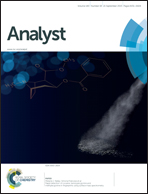Determination of ion pairing on capping structures of gold nanoparticles by phase extraction†
Abstract
As nanoparticles with different capping structures in solution phases have found widespread applications of wide interest, understanding how the capping structure change influences their presence in phases or solutions is important for gaining full control over both the intended nanoactivity and the unintended nanotoxicity. This report describes a simple and effective phase extraction method for analyzing the degree of ion pairing in the capping molecular structure of nanoparticles. Gold nanoparticles of a few nanometers diameter with a mixed monolayer capping structure consisting of both hydrophobic and hydrophilic and reactive groups were studied as a model system, and a quantitative model was derived based on chemical equilibria in a two-phase system, and used to assess the experimental data for phase extraction by cationic species. In contrast to the traditional perception of 100% ion pairing, only a small fraction (∼20%) of the negatively-charged groups was found to be responsible for the phase extraction. The viability of using this phase extraction method for analyzing the degree of ion-pairing in the capping molecular structure of different nanoparticles is also discussed, which has implications for the control of the nanoactivity and nanotoxicity of molecularly-capped or bio-conjugated nanoparticles.


 Please wait while we load your content...
Please wait while we load your content...